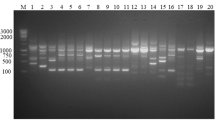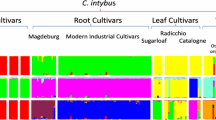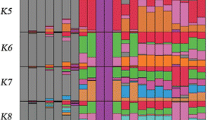Abstract
Genetic stratification associated with domestication history is a key parameter for estimating the pertinence of genetic association study within a gene pool. Previous molecular and phenotypic studies have shown that most of the diversity of cultivated citrus results from recombination between three main species: C. medica (citron), C. reticulata (mandarin) and C. maxima (pummelo). However, the precise contribution of each of these basic species to the genomes of secondary cultivated species, such as C. sinensis (sweet orange), C. limon (lemon), C. aurantium (sour orange), C. paradisi (grapefruit) and recent hybrids is unknown. Our study focused on: (1) the development of insertion–deletion (InDel) markers and their comparison with SSR markers for use in genetic diversity and phylogenetic studies; (2) the analysis of the contributions of basic taxa to the genomes of secondary species and modern cultivars and (3) the description of the organisation of the Citrus gene pool, to evaluate how genetic association studies should be done at the cultivated Citrus gene pool level. InDel markers appear to be better phylogenetic markers for tracing the contributions of the three ancestral species, whereas SSR markers are more useful for intraspecific diversity analysis. Most of the genetic organisation of the Citrus gene pool is related to the differentiation between C. reticulata, C. maxima and C. medica. High and generalised LD was observed, probably due to the initial differentiation between the basic species and a limited number of interspecific recombinations. This structure precludes association genetic studies at the genus level without developing additional recombinant populations from interspecific hybrids. Association genetic studies should also be affordable at intraspecific level in a less structured pool such as C. reticulata.






Similar content being viewed by others
References
Abdurakhmonov IY, Abdukarimov A (2008) Application of Association Mapping to Understanding the Genetic Diversity of Plant Germplasm Resources. Int J Plant Genomics 2008:574927. doi:10.1155/2008/574927
Aleza P, Froelicher Y, Schwarz S, Agusti M, Hernandez M, Juarez J, Luro F, Morillon R, Navarro L, Ollitrault P (2011) Tetraploidization events by chromosome doubling of nucellar cells are frequent in apomictic citrus and are dependent on genotype and environment. Ann Bot. doi:10.1093/aob/mcr099
Bachtrog D, Agis M, Imhof M, Schlotterer C (2000) Microsatellite variability differs between dinucleotide repeat motifs-evidence from Drosophila melanogaster. Mol Biol Evol 17:1277–1285
Barkley NA, Roose ML, Krueger RR, Federici CT (2006) Assessing genetic diversity and population structure in a citrus germplasm collection utilizing simple sequence repeat markers (SSRs). Theor App Genet 112:1519–1531
Barkley NA, Krueger RR, Federici CT, Roose ML (2009) What phylogeny and gene genealogy analyses reveal about homoplasy in citrus microsatellite alleles. Plant Syst Evol 282:71–86
Barrett HC, Rhodes AM (1976) A numerical taxonomic study of affinity relationships in cultivated Citrus and its close relatives. Syst Bot 1:105–136
Bretó MP, Ruiz C, Pina JA, Asins MJ (2001) The diversification of Citrus clementina Hort. ex Tan., a vegetatively propagated crop species. Mol Phylogenet Evol 21:285–293
Britten RJ, Rowen L, Williams J, Cameron RA (2003) Majority of divergence between closely related DNA samples is due to indels. PNAS 100:661–4665
Calabrese F (1992) The history of citrus in the Mediterranean countries and Europe. Proc Int Soc Citricult 1:35–38
Casa AM, Pressoir G, Brown PJ, Mitchell SE, Rooney WL, Tuinstra MR, Francks CD, Kresovich S (2008) Community resources and strategies for association mapping in sorghum. Crop Sci 48:30–40
Ching A, Caldwell KS, Jung M, Dolan M, Smith OS, Tingey S, Morgante M, Rafalski AJ (2002) SNP frequency, haplotype structure and linkage disequilibrium in elite maize inbred lines. BMC Genet 3:19
Coletta Filho HD, Machado MA, Targon MLPN, Moreira MCPQDG, Pompeu J Jr (1998) Analysis of the genetic diversity among mandarins (Citrus spp.) using RAPD markers. Euphytica 102:133–139
Cuenca J, Froelicher Y, Aleza P, Juárez J, Navarro L, Ollitrault P (2011) Multilocus half-tetrad analysis and centromere mapping in Citrus: evidence of SDR mechanism for 2n megagametophyte production and partial chromosome interference in mandarin cv. ‘Fortune’. Heredity 107:462–470
De Moraes A, dos Santos Soares Filho W, Guerra M (2007) Karyotype diversity and the origin of grapefruit. Chromosome Res 1:115–121
Deng ZN, Gentile A, Nicolosi E, Continella G, Tribulato E (1996) Parentage determination of some citrus hybrids by molecular markers. Proc Int Soc Citricul 2:849–854
Deu M, Glaszmann JC (2004) Linkage disequilibrium in sorghum. In: Plant & animal genomes XII conference, 10–14 January, Town & Country Convention Center, San Diego, CA, W10
Falush D, Stephens M, Pritchard JK (2003) Inference of population structure using multilocus genotype data: linked loci and correlated allele frequencies. Genetics 164:1567–1587
Fanciullino AL, Dhuique-Mayer C, Luro F, Casanova J, Morillon R, Ollitrault P (2006) Carotenoid diversity in cultivated Citrus is highly influenced by genetic factors. J Agric Food Chem 54:4397–4406
Fanciullino AL, Dhuique-Mayer C, Luro F, Morillon R, Ollitrault P (2007) Carotenoid biosynthetic pathway in the Citrus genus: number of copies and phylogenetic diversity of seven genes. J Agric Food Chem 55:7405–7417
Federici CT, Fang DQ, Scora RW, Roose ML (1998) Phylogenetic relationships within the genus Citrus (Rutaceae) and related genera as revealed by RFLP and RAPD analysis. Theor Appl Genet 96:812–822
Flint-Garcia SA, Thornsberry JM, Buckler ES (2003) Structure of linkage disequilibrium in plants. Annu Rev Plant Biol 54:357–374
Forment J et al (2005) Development of a citrus genome-wide EST collection and cDNA microarray as resources for genomic studies. Plant Mol Biol 57:375–391
Froelicher Y, Dambier D, Costantino G, Lotfy S, Didout C, Beaumont V, Brottier P, Risterucci AM, Luro F, Ollitrault P (2008) Characterization of microsatellite markers in Citrus reticulata Blanco. Mol Ecol Resour 8:119–122
Froelicher Y, Mouhaya W, Bassene JB, Costantino G, Kamiri M, Luro F, Morillon R, Ollitrault P (2011) New universal mitochondrial PCR markers reveal new information on maternal citrus phylogeny. Tree Genet Genomes 7:49–61
Garris AJ, McCouch SR, Kresovich S (2003) Population structure and its effects on haplotype diversity and linkage disequilibrium surrounding the xa5 locus of rice Oryza sativa L. Genetics 165:759–769
Green RM, Vardi A, Galun E (1986) The plastome of Citrus. Physical map, variation among Citrus cultivars and species and comparison with related genera. Theor Appl Genet 72:170–177
Gulsen O, Roose ML (2001) Chloroplast and nuclear genome analysis of the parental lemons. J Am Soc Hort Sci 126:210–215
Gupta P, Rustgi S, Kulwal P (2005) Linkage disequilibrium and association studies in higher plants: present status and future prospects. Plant Mol Biol 57:461–485
Hall TA (1999) BioEdit: a user-friendly biological sequence alignment editor and analysis program for Windows 95/98/NT. Nucl Acids Symp Ser 41:95–98
Hartl DL, Clark AG (1997) Principles of population genetics. Sinauer Associates Incorporated, Sunderland
Hayashi K, Yoshida H, Ashikawa I (2006) Development of PCR-based allele-specific and InDel marker sets for nine rice blast resistance genes. Theor Appl Genet 113:251–260
Herrero R, Asins MJ, Carbonell AE, Navarro L (1996) Genetic diversity in the orange subfamily Aurantioideae. I. Intraspecies and intragenus genetic variability. Theor Appl Genet 92:599–609
Ingvarsson P (2005) Nucleotide polymorphism and linkage disequilibrium within and among natural populations of European Aspen (Populus tremula L., Salicaceae). Genetics 169:945–953
Jarne P, Lagoda PJL (1996) Microsatellites, from molecules to populations and back. Trends Ecol Evol 11:424–429
Jombart T, Devillard S, Balloux F (2010) Discriminant analysis of principal components: a new method for the analysis of genetically structured populations. BMC Genet 11:94
Kamiri M, Stift M, Srairi I, Costantino G, El Moussadik A, Hmyene A, Bakry F, Ollitrault P, Froelicher Y (2011) Evidence for non-disomic inheritance in a Citrus interspecific tetraploid somatic between C. reticulata and C. lemon hybrid using SSR markers and cytogenetic analysis. Plant Cell Rep 30:1415–1425
Kijas JMH, Thomas MR, Fowler JCS, Roose ML (1997) Integration of trinucleotide microsatellites into a linkage map of citrus. Theor Appl Genet 94:701–706
Krueger RR, Navarro L (2007) Citrus germplasm resources. In: Khan I (ed) Citrus genetics, breeding and biotechnology. CABI Publishing, CAB International, Wallington, pp 45–140
Li WB, Liu GF, He SW (1992) Leaf isozymes of mandarin. Proc Int Soc Citricult 1:217–220
Liang G, Xiong G, Guo Q, He Q, Li X (2007) AFLP analysis and the taxonomy of Citrus. Acta Hortic 760:137–142
Liu K, Muse SV (2005) PowerMarker: an integrated analysis environment for genetic marker analysis. Bioinformatics 21:2128–2129
Luro F, Rist D, Ollitrault P (2001) Evaluation of genetic relationships in Citrus genus by means of sequence tagged microsatellites. Acta Hortic 546:237–242
Luro F, Costantino G, Terol J, Argout X, Allario T, Wincker P et al (2008) Transferability of the EST-SSRs developed on Nules clementine (Citrus clementina Hort ex Tan) to other Citrus species and their effectiveness for genetic mapping. BMC Genomics 9:287
Mabberley DJ (1997) A classification for edible Citrus (Rutaceae). Telopea 7:167–172
Mills RE, Luttig CT, Larkins CE, Beauchamp A, Tsui C, Pittard WS, Devine SE (2006) An initial map of insertion and deletion (INDEL) variation in the human genome. Genome Res 16:1182–1190
Morales M, Roig E, Monforte AJ, Arús P, Garcia-Mas J (2004) Single-nucleotide polymorphisms detected in expressed sequence tags of melon (Cucumis melo L.). Genome 47:352–360
Nicolosi E (2007) Origin and taxonomy. In: Khan I (ed) Citrus genetics, breeding and biotechnology. CABI Publishing, CAB International, Wallington, pp 19–43
Nicolosi E, Deng ZN, Gentile A, La Malfa S, Continella G, Tribulato E (2000) Citrus phylogeny and genetic origin of important species as investigated by molecular markers. Theor Appl Genet 100:1155–1166
Nordborg M, Borevitz JO, Bergelson J, Berry CC, Chory J, Hagenblad J, Kreitman M, Maloof JN, Noyes T, Oefner PJ, Stahl EA, Weigel D (2002) The extent of linkage disequilibrium in Arabidopsis thaliana. Nat Genet 30:190–193
Ollitrault P, Jacquemond C, Dubois C, Luro F (2003) Genetic diversity of cultivated tropical plants. In: Hamon P, Seguin M, Perrier X, Glaszmann J-C (eds) Montpellier. CIRAD, pp 193–217
Ollitrault F, Terol J, Pina JA, Navarro L, Talon M, Ollitrault P (2010) Development of SSR markers from Citrus clementina (Rutaceae) BAC end sequences and interspecific transferability in Citrus. Am J Bot 97:124–129
Ollitrault P, Terol J, Chen C, Federici CT, Lofty S, Hippolyte I, Ollitrault F, Berard A, Chauveau A, Constantino G, Kacar Y, Mu L, Cuenca J, Garcia-Lor A, Froelicher Y, Aleza P, Boland A, Billot C, Navarro L, Luro F, Roose ML, Gmitter FG, Talon M, Brunel D (2011) A reference linkage map of C. clementina based on SNPs, SSRs and Indels. In: Plant & Animal genomes XIX conference, San Diego, CA, USA, p 477
Park S, Yu HJ, Mun JH, Lee SC (2010) Genome-wide discovery of DNA polymorphism in Brassica rapa. Mol Genet Genomics 283:135–145
Peakall R, Smouse PE (2006) GENALEX 6: genetic analysis in Excel. Population genetic software for teaching and research. Mol Ecol Notes 6:288–295
Perrier X, Jacquemoud-Collet JP (2006) DARwin software. http://darwin.cirad.fr/darwin
Price AL, Patterson NJ, Plenge RM, Weinblatt ME, Shadick NA, Reich D (2006) Principal components analysis corrects for stratification in genome-wide association studies. Nat Genet 38:904–909
Pritchard JK, Stephens M, Donnelly P (2000) Inference of population structure using multilocus genotype data. Genetics 155:945–959
Rafalski A, Morgante M (2004) Corn and humans: recombination and linkage disequilibrium in two genomes of similar size. Trends Genet 20:103–111
Raman H, Raman R, Wood R, Martin P (2006) Repetitive indel markers within the ALMT1 gene conditioning aluminium tolerance in wheat (Triticum aestivum L.). Mol Breed 18:171–183
Reich DE, Goldstein DB (2001) Detecting association in a case–control study while correcting for population stratification. Genet Epidemiol 20:4–16
Remington DL, Thornsberry JM, Matsouka Y, Wilson LM, Whitt SR (2001) Structure of linkage disequilibrium and phenotypic associations in the maize genome. Proc Natl Acad Sci USA 98:11479–11484
Roose ML, Federici CT, Mu L, Kwok K, Vu C (2009) Map-based ancestry of sweet orange and other Citrus variety groups. In: Second international citrus biotechnology symposium, Catania, Italy, p 28
Saitou N, Nei M (1987) The neighbor-joining method: a new method for reconstructing phylogenetic trees. Mol Biol Evol 4:406–425
Scora RW (1975) On the history and origin of Citrus. Bull Torr Bot Club 102:369–375
Scora RW, Kumamoto J, Soost RK, Nauer EM (1982) Contribution to the origin of the grapefruit Citrus paradisi (Rutaceae). Syst Bot 7:170–177
Swingle WT (1943) The botany of Citrus and its wild relatives in the orange subfamily. In: Webber HJ, Batchelor DL (eds) The citrus industry, vol 1, pp 128–474
Swingle WT, Reece PC (1967) The botany of Citrus and its wild relatives. In: Reuther W, Webber HJ, Batchelor LD (eds) The citrus industry, 2nd edn. University of California, Berkeley vol 1, pp 190–430
Tanaka T (1961) Citologia: semi-centennial commemoration papers on citrus studies. Citologia Supporting Foundation, Osaka, p 114
Terol J, Conesa A, Colmenero JM, Cercos M, Tadeo FR, Agustí J, Alós E, Andres F, Soler G, Brumos J, Iglesias DJ, Götz S, Legaz F, Argout X, Courtois B, Ollitrault P, Dossat C, Wincker P, Morillon R, Talon M (2007) Analyses of 13000 unique Citrus clusters associated with fruit quality, production and salinity tolerance. BMC Genomics 8:31
Terol J, Naranjo A, Ollitrault P, Talon M (2008) Development of genomic resources for Citrus clementina: characterization of three deep-coverage BAC libraries and analysis of 46,000 BAC end sequences. BMC Genomics 9:423
The Arabidopsis Genome Initiative (2000) Analysis of the genome sequence of the flowering plant Arabidopsis thaliana. Nature 408:796–815
Thornsberry JM, Goodman MM, Doebley J, Kresovich S, Nielsen D (2001) Dwarf8 polymorphisms associate with variation in flowering time. Nat Genet 28:286–289
Torres AM, Soost RK, Diedenhofen U (1978) Leaf isozymes as genetic markers in citrus. Am J Bot 65:869–881
Uzun A, Yesilogu T, Aka-kacar Y, Tuzcu O, Gulsen O (2009) Genetic diversity and relationships within Citrus and related genera based on sequence related amplified polymorphism markers. Sci Hortic 121:306–312
Väli Ü, Brandström M, Johansson M, Ellegren H (2008) Insertion-deletion polymorphisms (indels) as genetic markers in natural populations. BMC Genet 9:8
Vasemägi A, Gross R, Palm D, Paaver T, Primmer CR (2010) Discovery and application of insertion-deletion (INDEL) polymorphisms for QTL mapping of early life-history traits in Atlantic salmon. BMC Genomics 11:156
Watkins WS, Ricker CE, Bamshad MJ, Carroll ML, Nguyen SV, Batzer MA, Harpending HC, Rogers AR, Jorde LB (2001) Patterns of ancestral human diversity: an analysis of Alu-insertion and restriction-site polymorphisms. Am J Hum Genet 68:738–752
Webber HJ, Reuther W, Lawton HW (1967) History and development of the citrus industry. In: Reuther W, Webber HJ, Batchelor LD (eds) The citrus industry, vol 1. University of California Press, Berkeley, pp 1–39
Weber JL, Wrong C (1993) Mutation of human short tandem repeats. Hum Mol Genet 2:1123–1128
Weir BS, Cockerham CC (1984) Estimating F-Statistics for the analysis of population structure. Evolution 38:1358–1370
Wright S (1969) Evolution and the genetics of populations. The theory of gene frequencies, vol 2. The University of Chicago Press, Chicago
Wright S (1978) Evolution and the genetics of population, variability within and among natural populations. The University of Chicago Press, Chicago
Yu J, Pressoir G, Briggs WH, Vroh Bi I, Yamasaki M, Doebley JF, McMullen MD, Gaut BS, Nielsen DM, Holland JB, Kresovich S, Buckler ES (2006) A unified mixed-model method for association mapping that accounts for multiple levels of relatedness. Nat Genet 38:203–208
Zhu C, Gore M, Buckler ES, Yu J (2008) Status and prospects of association mapping in plants. Plant Genome 1:5–20
Acknowledgments
This research was jointly financed by the grant AGL2008-00596-Ministry of Science and Innovation of Spain-Fondo Europeo de Desarrollo Regional (FEDER) and the grant Prometeo/2008/121 from the Generalitat Valenciana, Spain.
Author information
Authors and Affiliations
Corresponding authors
Additional information
Communicated by S. Hohmann.
Electronic supplementary material
Below is the link to the electronic supplementary material.
Rights and permissions
About this article
Cite this article
García-Lor, A., Luro, F., Navarro, L. et al. Comparative use of InDel and SSR markers in deciphering the interspecific structure of cultivated citrus genetic diversity: a perspective for genetic association studies. Mol Genet Genomics 287, 77–94 (2012). https://doi.org/10.1007/s00438-011-0658-4
Received:
Accepted:
Published:
Issue Date:
DOI: https://doi.org/10.1007/s00438-011-0658-4




